By Stephanie Anton
In 2015, as a long drought gripped Southern California, owners of larger properties in Beverly Hills and Bel-Air came under fire for the sheer volume of water used to maintain their estates.
The New York Times and other media outlets devoted extensive coverage to the question of whether or not these luxury property owners were doing all they could to conserve. The phrase, “drought-shaming,” entered the public lexicon.
Putting it drily
The drought year prompted homeowners to start investigating a variety of water conservation techniques, from low-flow toilets to xeriscaping to even using graywater as a way to keep their lawns green.
Years later, even though the drought has abated somewhat, many responsible homeowners have adopted some of the changes as a permanent part of how they manage their estates today.
As Capetown, South Africa faces its own water crisis, homeowners are wrestling with issues of conservation.
The world is watching as this major cosmopolitan city tries to stave off what is termed Day Zero, the day when the taps will be turned off.
For a time, Day Zero was forecast to occur in the spring of 2018. Now, through conservation efforts, water donations from other areas, and the building of desalination plants, that crisis has been forestalled to at least 2019.
For now.
Winds of change
On a global level, we are all subject to the weather's whims, from heat waves to blasting cold such as the storms that shook Europe earlier this year and the Nor'easters that continue to bedevil the East Coast of the United States.
The hurricanes and wildfires of late-2017 showed that disasters can devastate luxury properties. They also drove home the message that anything we all can do to mitigate our impact on the environment is likely a good thing.
Innovation in green and sustainable technology is at an all-time high and now being adopted from the top down.
No longer existing on the fringes of the design world, many of the most aesthetically pleasing products in both architecture and home design incorporate eco-friendly and sustainable features.
“Smart home” features do not just provide convenience for the residents. They can also make participating in green initiatives easy by regulating temperature automatically for rooms not in use and deliver important feedback on whether all systems are operating at peak efficiency.
Building smart
These days, sustainability starts from the first day of construction and has been embraced by manufacturers and marketers alike as not only responsible, but also savvy ways to appeal to today’s affluent consumer.
Smart building techniques that minimize waste, incorporate graywater recycling for lawn watering and high-efficiency windows, doors and HVAC systems are all requested by individuals building their own custom homes, as well as by buyers selecting new homes.
Younger buyers are especially interested in these features, not just for the energy savings, but for the peace of mind and the knowledge that they are doing their part to contribute to the environment.
Properties that are LEED certified provide an additional level of reassurance.
LEED stands for Leadership in Energy and Environmental Design and is a green-building certification program from the U.S. Green Building Council.
Other certifications include Energy Star, and the National Green Building Standard which was developed by the National Association of Home Builders.
Solar gets sexy
While solar power used to mean clunky and ugly panels, new technology makes solar more efficient and attractive than ever.
Tesla's entrance into the space helped to elevate the perception of the product and open the category to a whole new group of consumers.
More luxury homeowners are incorporating solar into their building plans or seeking homes with existing solar features.
Increasingly sophisticated battery systems such as Tesla's PowerWall make it easier to store energy, provide the freedom to go off the grid if desired, and make incorporating this technology a whole lot more attractive than in the past.
Heating up of geothermal
Geothermal heating and cooling are becoming increasingly popular, especially in chilly locations.
Geothermal heat and cooling use a ground-source heat pump that uses the heat of the earth to provide heating, air conditioning and hot water.
Particularly popular in luxury winter homes in Utah, Colorado, Wyoming and other cold-weather destinations, geothermal provides a creative way to heat large vacation homes with less impact on the environment and energy savings over the long run.
Exclusive agrihoods
One of the biggest trends in development is the agrihood, a development that incorporates farming, produce and other agricultural products available exclusively for the homeowners.
Inspired by the uber-local farm-to-table trend, the agrihood offers residents the benefits of living in harmony with nature and the natural beauty of gardens, orchards and vineyards.
The Urban Land Institute estimates that there are currently 150 agrihoods in the U.S.
One example, Kukui'ula, a high-end development on the island of Kauai in Hawaii, provides organically grown produce that residents can gather themselves or pick up from a stocked farmstand.
Homesites at Kukui’ula start at $4.8 million as this spectacular setting appeals to a select and elite group of homebuyers.
While this represents the extreme end of the range for agrihoods, quite simply, it is highly relevant to the affluent consumer today since owners of luxury properties are aware that they are not just residents of their homes, but they are also stewards of the land for future generations.
SUSTAINABLE AND GREEN features do not represent a trend, but an ongoing movement toward living in harmony with the environment while still enjoying the amenities of a luxury lifestyle.
Stephanie Anton is executive vice president of Luxury Portfolio International and Leading Real Estate Companies of the World. Reach her at [email protected].
{"ct":"LNFD2YGXd\/tenQjvifbOGBy1aiHmRLfMHsBlGnLrLdym+Y2\/he5yx1kFyIUPfhAe0RjZMjUDYLnoib9ATR4yu\/JlifhQ3DSznB1LxI6IxPVFMmiPSbMNkp532f1ujpYQBpmsgn\/4JEGT3eT0wl\/MMSlZPUNBCVQa76GsWPGprTjUaBjUlC7tXQVF8XTbvQGFHL1MCebVDI4lULMEL6shNL1FuP3\/bPHac7BXYrVWrNixKQjZa5vE\/8VRNKXKm4xEHBh7WT5MJBLFKb\/2N0odkMr1JpU9rFMbzfFehkswpChqmxoOUNOMJSay0G9M4U6hZJl91TSwKAAMeTo+8f7oIvuMJtyhRIFawByFFeeLGIEE3V7azp4UYy87HZwH0gbhZ4wqegV3oODWW\/1\/wlg9UiAlPfIKjSgNb346\/hhu0GWTMxnYHgxLdW5Q2OR+7Vj5yk61RupTNOIjDRy73gX2QuHLq4H4RSMS\/PBNlYwNlORLfb9iYzJdLBug1RmzvObU9qtht6KydnxCdcSzYgNqT5Z2bOVAKosIcLTm5cT3SdOGqg\/f6UZ6BBNWM0SgAMTCIiv3A0yMrzKv42y9RGPzInupnIszQPhwzif4QORb9T22hz9xk2oQrgKhaCUOPTFuILz4gFR+KzS4PJiubFQOj9T+2F3ItH8p0s+pBM2PchvoPBwi5dQdoXfw+Cqj5uCL1Wge41ZavgcVwNHYfFAr88gsXG9gh4b1A6EdpoDpQKjEgc3fE5d+Jesan2c00LQxmHDvH2qJMkrGn1CpRb6VYnCMi1fpwIpwtJJt5KePC8zdmmnER7Va94vRWsbY7KFgC0JyQGk2v\/9ImRCCuYHVYqCo52YgZVCOvvlA3t\/E23OZbsuqWb5lnsFVrC58qLHQ4kW7cRsOYxkl2cFmeBrRPF7w7r6yNdR6PUq2+DAruUBrnt+tJU\/GsdheEcdHax9P0a+\/lXQOWD71vrMmkGu0hTE3K2iaC9Asc9DcVTxpQr1brNG9JTpsiVPdky1DY\/m\/Ma8JJxjKPrvSj624NirlT43zgdG7fhSW3qIPFZv7TTj3T7o5XfGA1gxY1qffJbZznp2X07Qw+uJWWq+Txe3Ml1medMSn0CPLzSTxvCXGTVlY8vIb62brp1jEvaOlFgaHFaSE1qBXtTHl85Tnvg4+ysyYlFGnEDmvtQVqNWGwixG9O4GDaXBVctcQT9m4zgs7ApzUJQnOxcJDPiyVnW\/GEtoWEYAgcf8IoYmzVe5tdaMrslZDpNhALM+7hVraijniEpdeaH3GRzrwwqaE9bFsEEbS8Yzd3244+UjjMTFkRmIz\/d9ZGb3FRfMTFBrFQYv0FPDEHBL7kBV4mTFFLb7S9PZqbS9w21r4WYoU99r6U8lN2sysvBy2bKoYil18SyONU108hPNM0sVhvQzCBBaAlAvT7jb1XwhuswPdL7jYfxbcgcrzrT0oveHJ\/mSQAt\/Kgk0CyKoRaGCKPJpIJkAsTOKsgRqhVplxtaVugemvLBfZUUIn4jzo+iWJAUlFoDKtuSdp84ilvE8u7VIum1sqaP\/6jVX8EHqhQPk7skPW\/IxwnWN1keCEFx0lFgWyn2uAheTQamvDj6JMttpxyPh6PKl7GNmkCbXtrO266NhK7aPTu\/80GSSo9BGOmlZwdpplTdleCQh3I9GyGiuPcNXyNB3fO+TDuCjLkKGj5isnQCNaawycC+x5KXDwXA3i0dKhO9qNMr9iC40CZxtgM\/7iyvWdHTdMFIr2z5ZYCB9AT0GmhmCSG+\/QHJtRVvvygQr3Eqo+MeAZvM0t919tgs7tzcSL1y3NHMMzv3kP69fv4EPpz1EeOQaQSxzwktRpg3yPUVHo5YOzr4iWInPs+bYlvcufGGnrs8BNfgbr9vUOWXOey3nmQu42mxQ5j31cvP2VSGULzuTBkg2U+BkBoCrHOHUEnPWuY0\/xDfC2eR6kyiOtFTmnToVvHaSObyVFxG6BIKSQyjEzUOejvz5AkgsHRVVU73sdtuZXFd7H9TCY9iV83rXzXRH8uiiN6sjTdiE7F4UJ5h8iXgh5xsZN1BpHkZQ4pyHIA9O0Whn37omk40kbIN85dyXpizKpy2SgDYwpIJrI\/+0V1bLMwh3n4dDwJ6s8eR07wSR3Y90\/N12QHzJZKvPwPmef9A96FYX6Ao2vS5x4oOoaC9ud0abcR2ya3eEGY6opDNFxIgS3jnbH4r82K4smbmhTvO8uWewtvlfwul9ejM8LCgZ5rAYwz1FcCwgTWiQkuGAIdEb6ox6Oaq2GzDWBMlquUwcvLFNO3GbKxffAT\/\/uvC5SYg5gUMxUMvSmvnEX9\/dtrWhSlTbv+5TMJFg\/Jgf5ij6q24fXimEGDJugXtwPkCKkgL4af5rwmH093JQ02mojOG4ErEQQtUkZxQf7ShurxBKEzzdTRozpdsZg+rYKrIWegfLBZEjRxf+Na2JWVliw7Rce6M8N7DrX70xjbdQHBpXPzqRtNsYmObXzzrEwyrFcCg2EBUt6h57s2CNIBBL3emmv0HbfCaszRZB8LHUtXaoYfBWM9p\/TIfpqpCFKYd\/vjuEVIKyzQiwT80SoW4\/uFiWjoxOzh4bqNRal1IpeQYKfuMFlG2bwX2S6VLNDdGw9aK0JUBV2sw00rhEVas1wYZ6HyvXXWp1Xvmbe4zCMkzQVeHGbYg9n9Bw0wGjATN1GLsqvxn8egbURYppAMPm8DKXegrnJI4PlmI0JR4ww5\/ZfTHYERmGYkuCA7gIc9LiGSUCiibj18ZjwU4MQjJl3lzLFcsWT\/09rsjGXji9aL94xCwk\/dbclScd2oR2ODJff9XOiubtU9Bw6qrHIpmSObDqIFGRUk5DjIhOrH3\/J+S9F0g7BcGKgcN1898sf+tlzt\/90454Ak5iFEfGEwinf+Ut3CaqLJnnZ1kGnD3GCSxs1iQ6TBDup3q2C7palobOwynwJl9VaQSdPQ+l0u73qyhgE5qYi6\/cceu1HwmSkRcnhfkBVnQ2sSGGaXNtvOeF7yf0ejxJUqPyRsNkLP\/oWlGN4dKAaGS1J0ZO30cRI2nmBizVizstHUZsDY3hyv9Bj0uAquIfK98Z13qunhVtShShyr0Dkfsx5ibs1tKOuVY3zcjfaejTRi6+8pu5U8Kso+DpesSESWtc9+3aeOjrdN7PNIX4aI3VG9jmNKQP2icuacfW5CTAJW\/jpxTFMRyHACXGd5r4zEKt2038aDwEoyMv+3D3RmjnY4UzINj+8HY\/rF\/oqMCx5HxLrl+n0Pwl\/i01YIScmE4XU\/wlczclRTLyftbVdhqxQQ8qSPMpBJWf0A2P6akfLJHNbOCRw97z\/i2+Zawq7WnAuKIKeCkyVLFNZJFOstwEWC23YHkXG8QcBoxqkIv6C\/koGjosyKpUY6Sw7SaSY7k+djeVOpOXyoS1axShPisd3MMoru4tExMCzrDJKzpkr\/O9gurglDoNALDjlkeZ0gwRE2mJze8TrxprurTeplaE\/6pW88Y+NNaWuJJzReJ8AfI4XQXh8+OieZ4oXBFUCliWu6lnoyCn0hWvfdhkGDgJRV765UgifaZPSmq1N1ORmQ4EipfFcyXN\/wQ4l+MS\/2R8L1fPxhFX1F74v5pDhvp8q7GsjcO3AO4+VFodjPw1SPSg4GWAUNOoGNWhPxxQf1LT4qGL4S7zSdNV75zCbj4a43tqUDvombOgfWONn2lIonkS2HcvDwkaBP\/De41Equ986nYLO+EemhScsnQbk3teSmaO+aKnFHN4KX+Dagznzebl1dcthVQmDhkXe94zc53HxYlOKH9oi64o9\/5F9KoU915hR93ECrbzREkWOWRa\/EqmWW5W8ffwu\/3KF6KRynmxgS3S45kadW6JsNAXGG\/X\/MRbo5ETPSmNyipkhL7I9cmCrHKEUNdbIaS+zAZ4zqMxmlvAUWS6MDq+6b06GD7jgVlhuicrQy7\/rm8qHKtNdyeojRV6dpjuNGzgq4tj3FCAmRW4eIRJeXTaJjSlo1HMEbhkKQ2YfukXu0HMorjex25QXlIWJagzPU7XpAWdFCUsPAe2T2\/39ztL+6Y+7HexFzjNQ3ncwbcunWarkEiRb8rmaoZoJp6MXxoPM2qLraQAXbtMY23S4rcGfmdsQlo2xVIbB2LOKWmTRM6DLjrtFP+gOUaJYL9Im7bBTrMazKhRmhZVc5koyL14BWxvniHxq7OjIgbMw4UXZX1CBq9ah3XTNogfb6V07IqVnrO5EFga4zExXCTcCe01+8pnfJhkHaESnWt+twEHtJwd5XfprM\/HfUGwvdxDyBKmIeZBP4Y5rTLVbhstSqFpd6BC7bOw4UXxANNp4PoBAIaidmF3sSuUeUthOxQu8btgaR8DCwPzRLJvGd+KznVU6dRUQQVWf+XgT88GQNOHRlsIVcY6fbJPUYOqQGmq9gTTmIPn8OogVHLGF8FK8V0dWhiBAY6J65mNTiIKQ2TIMeP8JxzwVQuoahB7MD9LPOvhtiKaDx6wo8dxLxdFUgDcZzf7LzNFKCzWbJPtRKnkhwRWxO+rPZt2NnXgsKXEFuC0mdknWTrDWsYiT1oc8Ou3WsJ1ZZDQvwk9O104BIVAUkma5M+QaRPdPPKvtcWWaWFRSo6SHpvavQo\/jQaWK7lIyiORDXpa3HBt9HEfqlcIKU2DbaLQb5Ten0bsQ8mE+5snbdQp7uTNDfxqImps+mvOsdAJ7D3hFt0MSaoJ2Oh04aHHZQspwi2qrwjZ0GDrIZAI8hH\/aEhzhdW+XtOQLlL99y4RL4Yn94sSslrZ4J5nJpaY\/uQHnFCwGKqnBdpf2aDOIWPQh7wkHqDrd+5zmf5JpnSce3T0r9yEinbzog06inKi1pd8usAyxTySXdNM37yDAkG9cm\/9dBFydU5q\/S+zZUXvurmAETJPO25CGl0WoTnuWNX4gyg\/hgCz4jh+qtXUIhXhKUJ8dnLYfdVxzlBaFbDBf0VFWVR932CB1dSBLnHa0EQLB72x6UywPvRkvVqjNdBS2ZaqjFWp1xcJCZ8Yo\/j\/OqwsrNTm6OQlTK0HLDVP+FGtzLwxW\/yuSZDaFrkdBEvCkozase4y9HN5pm3gGL34OqS03ZVCmiCLQv5H4bV14eq\/+EP\/\/wnHowfMEMG3Uji7RCd4BuYeB\/xXBDRHbpZCsXBDZVT1XR8jA7kvzoaIoiVsJTfsyjtwi9LPWpQT2AQJRlrGKUfpR\/L81SRi\/G6W7SDgR6qcr6wFGGlOIijNRA5WR4PnK1D7kRY2k+L+3p2Rd7EdYj4rxn\/YQwjqaIC7mQW8JroJ3IDfoQSb2BqPNabKpA9XOUMW+rcRBdLdfWmRvS3I3569Sd+vBtBG9NugEFUJKEsNYOWgae\/yP\/64pA0Zu\/0ofjUR0dOmMDOmehvfUjAIDJK6B6L1pvlCKx5mXsq\/6EVIC\/TSlDKbFXxHBbrbY\/nyVqovHtT7Z\/gUxRz6XZdE8tPQtsUcTYTX5llc9HcrzyvRgQKLoLLeobE001JzftRzyJ1LnNPtMFRRvD00t7r6cwWQV54bajI0t9sX0N360xDcDQOmi8nTDLACkJs4L3B123gRc5FrNIvW+v39X8p0xTsdKsr7Zx\/omKc0epID797LxzxjdgEmx8RHRaof53NxoQv8ch+JrG+s6lFR8A4lCbU9d9kWPZNvRKiBk5PNKZze2wNxZNqWCVEoeDCvwQbCOeKOXwYFp4PeMYatkcoIo7uSPZ3zuzB7Q\/Y6KWyfBLI0Wd5xGs6FHmLpE3wkSoaDd3WIQA3Jeq4AztG3VRuHtji\/fmVsW\/qPmd9PmCEdDbvQmLSNCQzSwUpVstztuPDNZQdbPPeIGK5y+OQ4LrxTftWRRlOk70U8hcoTsP1GcvlchNpzwgnKoExRrhBgP3nPZ6tBtIP8b5oRFhLFiNHQfDmED0fTWvQTR60jJiiV1uPU6Kv6+frIUjBP5IyCi4bQcJcnJIUQhJYRB87LsdKU6PxmCr1b07CDfzoQgTz9bq\/PztQ0AsBoFPqFYEFOsezZByXQepAKsN6+yXLjEuag0VziCsiFQXCf2VwBJ9ydmxsfcTSDvv+PIR05vToRjiChO+WgJ7tgD6YgfXQ5x\/9ZGGF9yt8oK3wzkfcVFwcaR56h+e0\/D+\/EeD93bbksT4NMPasMZlWLObrtQpxGRWUxR0uX86NuRhOYyuw8+V\/gR5nY246ixhKF531aOmB0uhFk0cshoDPDnyomgFf4RE76aKM+v4vY4bTXApWvesyqi+984hr65Xn+knSGimx7lHkK\/dQK5z47EjbHWLf5hH\/4H+yl7Hgqqhoi3uns67Y14mlQGULDWb6btl8dZE6HGCwtTNnVo5rsQkslpZXo2t\/dFFU7jfXxpRRD7TllAK0pwzd7QffbR6OPi0naSWMmOxplZU0sMY3tM2WFGj719pBtAtuXpTEO13jz52tOiWsVHkaKHkrxP7Qy9Bm83T1xj3XFPQAccap+rp7TBnlltqFt5byhPocT9DzpBukIjFITyhZEGpwHu7ReZg0UUfAdQ0XL7p6+\/KbUt9wgHj4ROrTz9SU8wdso9hInE\/esdj5b5wtjReZ6l1FMyu3D3hW\/EMX5qxGvI7qKOBTwhitYkjowvSXEIFUHuch1yT8nb0ogCISauJiKasB0Z9E9ZZjpTJHDT9weqF2mjaZohr+k4TtO9vCBrKp0SwUZRCx3bhS4vT8zhdw7Yb+ua\/RyZ8Y81cwyQO8K2QvOipBNLogpriycldJEcLsxXutZ4IdpMPgu7oQAHjX4bbEnh4+DACPDuY18kwJWVkCvi9BV9n8J4PZPHXAMRDaNam6gZwcbdVJO0ZwhsqEJGJifyxAwrwwB1nYvj\/DWkliSyvoHQWYdD5og6EnVERUO\/MCKt2r8x8BjQQzIFXBH3TAmapTLrBLrBH4xE+EkqKaOwJPoJiiD0pwKTMm9TTmavU+tyCu1kO+iaPfN\/h5uSB6d\/BZt5SSQv6aHxxn2liMxU54oHsPP8WxOig1GmCH+zU1MNuXYsXOVW3p+9o87LZdrVHU6Gf+N+rO\/YLGkYlAMOGckTeQQxsUx1CRvRU0X9oouuQd1BnrI1wEjhci2cQ4D5wc1ABNdYNgTOBPNaGEyVF0DO1N3ern4wd9gk4T5saNiXvzLPRW\/fQYfq4LojCUwkiMRkr13C3dacDo1pySe0rCvvAUnKvKH56A\/FWuy+3UXdNriQXHfblCSI+V3k0YqZmB+w8iKzT4vsEeOY3mo36k2NNAG1Asu42dmWiHHhSdmotFm\/oJLsSszFSLS2XAtJeN79W\/oOfduVJUnQ0NYJCgTYXs2QPnPr2rb1r9GRUTUnts1WLG3qj1IH0OCpfIxE0ogfMSvywTKg81DOTiL8f+phaBZAR5X\/Tl0zcZJqblBRBJUIeVMqdjht9DFTQxWnZedELrjZ6OXbXrVXjfQS987px+IW5S8ZYCKN9b\/4OWip7GajKCBYR6JmHsd+iuDU08KxS+WMb9BCQ9H2h2OL++A8AKC4FzrxaVrSOkzyM3mk\/xZ0NLu42\/mlv\/xf\/dl7DQiM782RIXRbUq0UGLlzyUAI4\/8WttIRKxIuJWhPTrjNP0UHRDnGwPgaMQCVxNuhrkhbgfEot2AQwAEs2L9PxamyWYUZMw3KPUFnGiI2j1NojvSeTO0C5uPPA+uVKDaZHXzL5BltYdrSNf4nYPr9N+Dnl4uv25vVefSOZu6zLetCrIa15mA6DQb8YRF\/VtBG56nFfMdiZlbLZXTUfTfzZiTPjrH2L3GxlDt8sjrMZGTbTS9mcM33UVWaro0OYDZF2ECMbbHgW5B3MIvQfsCgIzcBRWzIG3SsGAWT3s4S3nTsngmACAMYpaGsUc4cg6bMHKBCUUrmS5QpzJPdGdEoVCh3zERP0jQbd0GM0ES15brX9GfOViIlB9ut2PVAvj+U6cBOW5sCvVElkT8Tx98YzYmXQCxlXqbMa2LqTp5jPgCEoQ4HIfpWMMkPo+Hvr\/6q0eQe81OxC\/Iu2BHwF5TgP7I+E2VXVYfrYBuQ5mhXVy9wD5iYbveRebckk1QMQ\/NDuQUd\/fdZ1pyDon4WMp9odyg93kgrH6aNwS59A9VAPPBvv\/fWYZWeVThkIywXWI8ryn+YSJFohGIiOot4t44jAWDGfrK\/JztLekherdybkxS8vprK+vV8Z5WYPQr1LeYLNyfVtxGGKgDnr\/4lc4PuojaxMw4XNEaOva0C\/2tOP3FxTYDjW8ZTL5F9jkEcOnf07mvYwgffQPvZfAJzs0BfvE5lRzWj7Stmvlot49mah0HnZNTBWIYh5dpaZyyG9jxIJUa762GYdvgYDtA1gaZqPWNh8gr3ckuVIh15stxyTeUbkaLCbBIhuJdfxQVZX\/gTa0QBSNM288skIbl9fG7VKKKHnWgJFsEADkQZXwyc7XiT0t\/u7Io8\/LICpKS9hYdbrLmB\/oQsX3IRudgVSAXXpLEpUIdT0zdpRa8BP8uSRGIOvG3Op3e0L76Pz8GRFVOe3qHMDt1JYXJRFLYWXZWVImv5OITZw4dxDorP06voj9NXMJhzP2BoMeOtMD2OTi9sH9Hq3d2nEMz5Ttpa2bQnWZAOjgB1qb73fCC2GdW\/xU1FayF38Lewhg6\/l3sIiL73TPqOHv5T5OgvkTqQVUPlh5K1MWdYdr\/VqC595w5Jb7NvaRueqUMS2\/+wO7IPDtnl5pLQk5FNFbPFDfSpfpnfQOyPJgaixHWlXxkE6GVFaQPJiYjfIKOlySKNzfilA7WWLXF80i2gCDJ82+gYltCixjDJYKmhJ+465O+Wr69zMWCC5dCj1jcdfY3t4smMvgbviGIskfrLCCaK8Volg5ulvBqzrRVaKxq1FKat43c5\/oMnQEEPLfSxTEH+XbxCB1A7lDqYIfK68zdarIHYPR2CSqBU3t5LskpKjmd7N+sRhFBeh15gIRmmQt4QO2pMmH3PDhJM6dunQe2VqF7j2u2LnSFctJ\/SfUJ+togPAoCt4la7VXJdfhPyhxDKVAhKwdT+HMlT2SVBPVWZCAneftL2tb5xc1rnrU6nEodQSUIsgF3MOC4gRx\/c5yZfag1oIv3+iJoqjJ2N3j43XpqxforqFbIL+qXpVmCi5W4ClEKhk4RVhCGk+jdBNwr4RCkwBzpikLddVtIFcBHMOoF4DiNUiVkbSs5l48VRZZnBV1vRsmdDA\/D3uHOFff\/KRrPz4RUhMVWXomE\/","iv":"3968960c4b0fff533afa8b01e6b340ab","s":"ef8866114fbcb4d7"}

 Stephanie Anton
Stephanie Anton